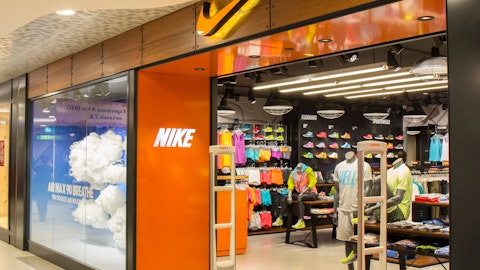Randy Connick: Super helpful. I guess my last question would be, I think I’ve also asked about this in the past, is the concept of fittings and customization and how the industry is moving more and more towards that kind of model. Maybe give us some perspective of where we are, where we’ve come from, and how that’s kind of changed in terms of changed, let’s say ASPs conversion, working capital improvements potentially in the business, and the way you’re running your business, but then the whole industry is being run. It just seems like a bigger opportunity for you and others, and there’s only a few others given its oligopoly or a consolidated industry that it’s just a better-run industry now with a lot more stability and pricing and margin. So maybe kind of comment on what you think there on those thoughts.
David Maher: Yeah, so high level. Randy, I’m going to agree with all your points, but I’ll dig in on a couple of observations on how they play out across the industry. So, we’ve been dedicated to custom fitting for 30-some-odd years and we continue to build out and refine our fitting efforts. And as Sean said, we continue to invest more and more in fitting. It just becomes a clear place for us to invest money because it results in all the benefits you described. But most importantly, we know it’s the best way for golfers to experience and ultimately select golf clubs. Years ago, fitting was isolated to outdoors. Now fitting is happening almost everywhere with the advent of launch technologies and indoor simulators, there’s a whole lot of education happening on the fitting side.
So fitting continues to grow. It’s most evolved and advanced in the U.S. and Europe. I’ve said this in the past. It’s got a long way to go in Japan and Korea, but we’re moving forward. And one of the benefits that I think fitting lends itself to is just a reality that comes at the end of product life cycles. You have less product, less stock product in the market, therefore you’re discounting less stock product. And as an example, right now, you’re seeing a lot of new driver launches from our competitors in the first quarter. And typically, when that happens, you’d see a good amount of sell-off of prior generation. And while that’s happening, it’s not happening to the degree we’ve seen in prior years. And again, I think that’s a positive ancillary benefit of because so much of the business nowadays is happening through custom fitting.
So it’s been a great transformation. You’ve also got new channels emerging, right? You’ve got indoor fitters, teachers emerging because fitting has become so prevalent across the industry. But again, as it relates to working capital, as it relates to margins, as it relates to the overall golfer experience, all positives. And I think it’s a trend. I made the point, we’re 30 years down the road here and we keep building it out. And I would imagine that trend will continue. And it’s compelling us to keep investing in custom fitting, which again, if nothing else, gives you confidence, gives you a sense for our confidence about the opportunity moving forward.
Randy Connick: Very helpful. Thanks, guys.
Sondra Lennon: Thanks, Randy. Operator, next question, please.
Operator: Thank you. Our next question is from Mike Swartz from Truist Securities. Mike, please go ahead. Your line is open.
Michael Swartz: Hey. Good morning, everyone. Maybe just as it pertains to guidance and more specifically gross margin, as we typically think about a non-Pro V1 one year in even years, gross margin, I know, is typically down year-over-year, but if I’m doing my math correctly, based on your guidance, I think it would imply gross margin of flat to maybe up slightly. So maybe, I guess, is that correct? And then maybe walk us through some of the puts and takes around gross margin as you think about it in the year ahead.
Sean Sullivan: Sure, Michael, happy to. I think that we’re not guiding specifically to margin. I don’t think your assumptions, though, are far off. I think the biggest item probably I would call out is freight. We’ve seen freight normalize, so that will be less of a tailwind I guess that it was in 23′ versus 22′. So we think that normalizes. We think that we get some more normalization in the supply chain. I think I’ve talked about raw materials and we have pretty good visibility in terms of what our costs are by product. So, it’s really a freight conversation and again, I don’t think your assumption is too far off.
Michael Swartz: Okay. Great. That’s helpful. Maybe if we just look at the range of guidance, and I know the range really isn’t too wide, but maybe help us understand what are the assumptions at the top end of that guidance? What are the assumptions at the bottom end of that guidance?
David Maher: Yeah. I think Michael certainly will. It’s an appropriate guide for our business, certainly, this time of year, right? We’re late February, and so much of the golf season is in front of us with the majority of rounds and fittings happening, really in Q2 and Q3. There is a wide variety of puts and takes. I would say, hey, unlike past years, there’s more supply chain certainty this year than we’ve experienced in the last couple of years. Sean mentioned the footwear category, we expect to stabilize here in the mid part of the year. So there’s more marketplace clarity and certainty in the wild card, as it always is this time of year, Q2, Q3, weather participation, etc. We like the way we’re trending, but I think you get a better insight and answer from us, maybe on a subsequent call.
Michael Swartz: Okay. Great. Thanks.
Sondra Lennon: Thanks, Mike. Operator, next question, please.
Operator: Thank you. Our next question is from Joe Altobello from Raymond James. Joe, please go ahead. Your line is open.
Joseph Altobello: Thanks. Hey, guys. Good morning. I guess the first question, a little bit of a housekeeping question here, but what’s the contribution from Club Glove that you’re assuming in your guidance?
David Maher: Yeah, Joe. I think we have said it’s less than $20 million in sales. It’s EBITDA accretive, but again, not material.
Joseph Altobello: Okay, perfect. And then in terms of the new golfers that you’ve seen enter the sport over the last, call it six years, how do they differ from typical golfers in respect to how often they trade up in terms of their clubs, where they buy their clubs, are they more inclined for fittings, etc.




